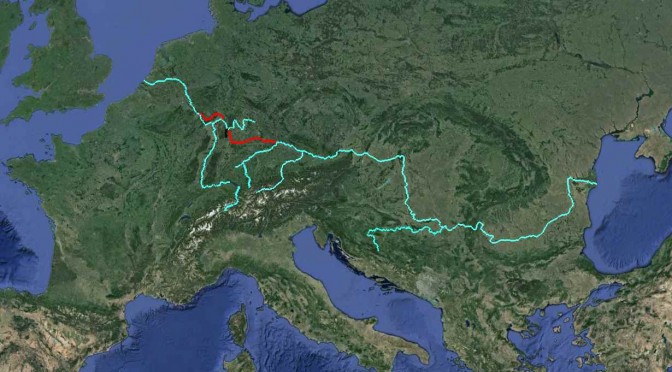In Rome “Comes” came to mean “ Friend of the Emperor performing an important role”.
As the Empire grew bigger and the power of the Emporer grew, the Comes themselves became more important. It was the Barbarians invading the boundaries of the Empire which were the catalyst for this change.
Source of the Danube
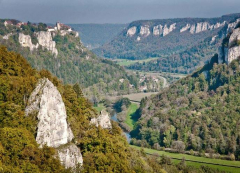 The Danube’s source is remarkably close to the source of the Rhine. It is very similar but not quite as formidable a barrier in its upper reaches, which is presumably why a wall was built between the two.
The eastern end of the wall was Castra Regina, today’s Regensburg, at which point the River was considered wide enough to be an effective frontier.
The Danube was never as secure as the Rhine however perhaps because the Romans did move across it to establish the Province of Dacia ( todays Romania). Dacia was part of the empire, the Danube was bridged and there was significant civilian river traffic. The river became not so much a barrier as a thoroughfare.
There was another side effect to the Roman presence in the Carpathian mountains. it opened up an alternative trading route to the east, by passing the Persian Empire which was in continual conflict with Rome and in any case charged high taxes for goods passing through in both directions. Unfortunately much further east this sensitised a nomadic group of expert horsemen that there was a rich, by their standards very rich civilisation in the far west. The trade route was a trail which guided them and before long the Huns were on the edge of Europe, putting intolerable pressure on the Germanic people living beyond the frontier.The Danube’s source is remarkably close to the source of the Rhine. It is very similar but not quite as formidable a barrier in its upper reaches, which is presumably why a wall was built between the two. The eastern end of the wall was Castra Regina, today’s Regensburg, at which point the River was considered wide enough to be an effective frontier.
The Danube’s source is remarkably close to the source of the Rhine. It is very similar but not quite as formidable a barrier in its upper reaches, which is presumably why a wall was built between the two.
The eastern end of the wall was Castra Regina, today’s Regensburg, at which point the River was considered wide enough to be an effective frontier.
The Danube was never as secure as the Rhine however perhaps because the Romans did move across it to establish the Province of Dacia ( todays Romania). Dacia was part of the empire, the Danube was bridged and there was significant civilian river traffic. The river became not so much a barrier as a thoroughfare.
There was another side effect to the Roman presence in the Carpathian mountains. it opened up an alternative trading route to the east, by passing the Persian Empire which was in continual conflict with Rome and in any case charged high taxes for goods passing through in both directions. Unfortunately much further east this sensitised a nomadic group of expert horsemen that there was a rich, by their standards very rich civilisation in the far west. The trade route was a trail which guided them and before long the Huns were on the edge of Europe, putting intolerable pressure on the Germanic people living beyond the frontier.The Danube’s source is remarkably close to the source of the Rhine. It is very similar but not quite as formidable a barrier in its upper reaches, which is presumably why a wall was built between the two. The eastern end of the wall was Castra Regina, today’s Regensburg, at which point the River was considered wide enough to be an effective frontier.
The Danube was never as secure as the Rhine however perhaps because the Romans did move across it to establish the Province of Dacia ( todays Romania). Dacia was part of the empire, the Danube was bridged and there was significant civilian river traffic. The river became not so much a barrier as a thoroughfare.
There was another side effect to the Roman presence in the Carpathian mountains. it opened up an alternative trading route to the east, by passing the Persian Empire which was in continual conflict with Rome and in any case charged high taxes for goods passing through in both directions. Unfortunately much further east this sensitised a nomadic group of expert horsemen that there was a rich, by their standards, very rich, civilisation in the far west. The trade route was a trail which guided them and before long the Huns were on the edge of Europe, putting intolerable pressure on the Germanic people living beyond the Roman frontier.
The Upper Rhine
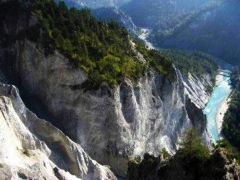 The Upper Rhine is difficult to cross right up to it’s source high in what are now the mountains of Switzerland. This meant that the road to Rome for those who did cross the Danube was through Pannonia(today’s Slovenia and Croatia) and across the top of the Adriatic.To the West of the wall the Upper Rhine provided a second substantial barrier .
The Upper Rhine is difficult to cross right up to it’s source high in what are now the mountains of Switzerland. This meant that the road to Rome for those who did cross the Danube was through Pannonia(today’s Slovenia and Croatia) and across the top of the Adriatic.To the West of the wall the Upper Rhine provided a second substantial barrier .
The Upper Rhine is difficult to cross right up to it’s source high in what are now the mountains of Switzerland. This meant that the road to Rome for those who did cross the Danube was through Pannonia(today’s Slovenia and Croatia) and across the top of the Adriatic.
Despite the strength of the defences along the Rhine frontier there were continued attempts to break into the Empire. The area running parallel to the Rhine became a permanent militarised zone. Most of the towns and even the villas were fortified. It was here for over a hundred years that the Comitas honed their craft, becoming regional commanders who co-ordinated civil and military cohesion and developed longer term strategies which involved the whole population of each region. On occasions the records identify them as “Counts” rather than “Comes”
The Alamanii
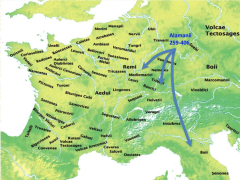 Despite the strength of the defences along the Rhine frontier there were continued attempts to break into the Empire. The area running parallel to the Rhine became a permanent militarised zone. Most of the towns and even the villas were fortified. It was here for over a hundred years that the Comitas honed their craft, becoming regional commanders who co-ordinated civil and military cohesion and developed longer term strategies which involved the whole population of each region. On occasions the records identify them as “Counts” rather than “Comes”
Of all their opponents the most persistent and ultimately the most successful invaders were the Alamanii, who for over fifty years regularly made their way into Roman territory.Of all their opponents the most persistent and ultimately the most successful invaders were the Alamanii, who for over fifty years regularly made their way into Roman territory.
Despite the strength of the defences along the Rhine frontier there were continued attempts to break into the Empire. The area running parallel to the Rhine became a permanent militarised zone. Most of the towns and even the villas were fortified. It was here for over a hundred years that the Comitas honed their craft, becoming regional commanders who co-ordinated civil and military cohesion and developed longer term strategies which involved the whole population of each region. On occasions the records identify them as “Counts” rather than “Comes”
Of all their opponents the most persistent and ultimately the most successful invaders were the Alamanii, who for over fifty years regularly made their way into Roman territory.Of all their opponents the most persistent and ultimately the most successful invaders were the Alamanii, who for over fifty years regularly made their way into Roman territory.
The successful invasion
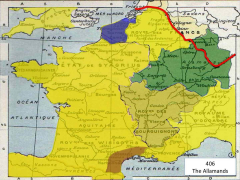 In AD 406 the Rhine froze over, not a common event and the Alamanii poured across. This was a real invasion, land tenure changed. The Romans sealed the border behind them but Alamanii were never dislodged. They became a separate nation within the Empire, making no tribute to Rome and most importantly paying no taxes.
Authors note:- This the first of a series of slides which which shows step by step the changes in the western empire until is demise in 486. Some of the underlying text has little relevance to the first slides in the series.In AD 406 the Rhine froze over, not a common event. The Alamanii poured across. This was a real invasion, land tenure changed. The Romans sealed the border behind them but Alamanii were never dislodged. They became a separate nation within the Empire, making no tribute to Rome and most importantly paying no taxes.
In AD 406 the Rhine froze over, not a common event and the Alamanii poured across. This was a real invasion, land tenure changed. The Romans sealed the border behind them but Alamanii were never dislodged. They became a separate nation within the Empire, making no tribute to Rome and most importantly paying no taxes.
Authors note:- This the first of a series of slides which which shows step by step the changes in the western empire until is demise in 486. Some of the underlying text has little relevance to the first slides in the series.In AD 406 the Rhine froze over, not a common event. The Alamanii poured across. This was a real invasion, land tenure changed. The Romans sealed the border behind them but Alamanii were never dislodged. They became a separate nation within the Empire, making no tribute to Rome and most importantly paying no taxes.
The year of the migrations
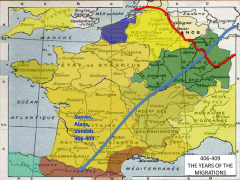 In the same year other Germanic peoples used the fact that the Rhine was frozen over to penetrate the Empire. They migrated to Hispania, presumably to get as far away from the Huns as possible. Nevertheless as they travelled west they lived off the land as they moved through Gaul, causing great disruption.
Now populations throughout Gaul sought the expertise of the Comites as they became increasingly aware of the dangers they faced and prepared to incorporate military defences with civil administration.
In Hispania vast tracts of land were removed from Roman control, another major loss in taxation.In the same year other Germanic peoples used the fact that the Rhine was frozen over to penetrate the Empire. They migrated to Hispania, presumably to get as far away from the Huns as possible. Nevertheless as they travelled west they lived off the land as they moved through Gaul, causing great disruption.
In the same year other Germanic peoples used the fact that the Rhine was frozen over to penetrate the Empire. They migrated to Hispania, presumably to get as far away from the Huns as possible. Nevertheless as they travelled west they lived off the land as they moved through Gaul, causing great disruption.
Now populations throughout Gaul sought the expertise of the Comites as they became increasingly aware of the dangers they faced and prepared to incorporate military defences with civil administration.
In Hispania vast tracts of land were removed from Roman control, another major loss in taxation.In the same year other Germanic peoples used the fact that the Rhine was frozen over to penetrate the Empire. They migrated to Hispania, presumably to get as far away from the Huns as possible. Nevertheless as they travelled west they lived off the land as they moved through Gaul, causing great disruption.
Now populations throughout Gaul sought the expertise of the Comites as they became increasingly aware of the dangers they faced and prepared to incorporate military defences with civil administration.
In Hispania vast tracts of land were removed from Roman control, another major loss in taxation.
In AD 202, the grant of citizenship to everyone living in the Empire had resulted in the gearing of taxation to welfare became unsustainable. Further losses in taxation led to debasement of the currency and that in turn to inflation.
Trading activity slowed as the Empire’s trading network was disrupted. Individual geographic territories became self reliant and militarily independent.
Internally there were financial and administrative issues which could not be solved. In AD 68 the denarius contained 95% silver. In AD 270 the silver content was only 0.02%. In AD150 a measure of wheat cost seven drachmas but AD 270 the cost was120,000 drachmas , inflation of 150% per year for a hundred years! Debasement of the currency, activities of tax farmers, legislation to control prices, prohibition of people changing occupations was all part of a sorry story. All these measures led to the strangling of trade and a disincentive to take part in farming or industry. There was not enough revenue to balance the budget. Increasingly the Western Empire reacted by arranging for administrative simplicity.
Military state
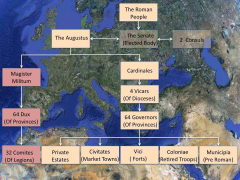 Trading activity slowed as the Empire’s trading network was disrupted. Individual geographic territories became self reliant and militarily independent.
Internally there were financial and administrative issues which could not be solved. In AD 68 the denarius contained 95% silver. In AD 270 the silver content was only 0.02%. In AD150 a measure of wheat cost seven drachmas but AD 270 the cost was120,000 drachmas , inflation of 150% per year for a hundred years! Debasement of the currency, activities of tax farmers, legislation to control prices, prohibition of people changing occupations was all part of a sorry story. All these measures led to the strangling of trade and a disincentive to take part in farming or industry. There was not enough revenue to balance the budget. Increasingly the Western Empire reacted by arranging for administrative simplicity.
The military forces to responded directly to the Augustus and took a steadily increasing interest in civil administration. The Empire slowly became a military state. This was facilitated by the appointment of a “Magister Militorum”. The civil administration concerned itself with taxing and disciplining the general populace, a thankless task compounded by the increasing necessity to take orders from the military.
The role of Magister Militorum was in the latter days of the empire frequently filled by the chief of a tribe who had been successful in acting as foederatii. In the case of the Visigoths despite their notional status as Foederatii they were allowed the right to become inheritors of the southern part of the Western Empire, assuming both civil and military roles.
The Comes began to organise themselves locally for their own defence. They could no longer rely on organised support from a central organisation. Some conflict between Comitas and Magister Milatorum was inevitable. The Comitas became increasingly independent and self reliant in the area they controlled.The military forces to responded directly to the Augustus and took a steadily increasing interest in civil administration. The Empire slowly became a military state. This was facilitated by the appointment of a “Magister Militorum”. The civil administration concerned itself with taxing and disciplining the general populace, a thankless task compounded by the increasing necessity to take orders from the military.
Trading activity slowed as the Empire’s trading network was disrupted. Individual geographic territories became self reliant and militarily independent.
Internally there were financial and administrative issues which could not be solved. In AD 68 the denarius contained 95% silver. In AD 270 the silver content was only 0.02%. In AD150 a measure of wheat cost seven drachmas but AD 270 the cost was120,000 drachmas , inflation of 150% per year for a hundred years! Debasement of the currency, activities of tax farmers, legislation to control prices, prohibition of people changing occupations was all part of a sorry story. All these measures led to the strangling of trade and a disincentive to take part in farming or industry. There was not enough revenue to balance the budget. Increasingly the Western Empire reacted by arranging for administrative simplicity.
The military forces to responded directly to the Augustus and took a steadily increasing interest in civil administration. The Empire slowly became a military state. This was facilitated by the appointment of a “Magister Militorum”. The civil administration concerned itself with taxing and disciplining the general populace, a thankless task compounded by the increasing necessity to take orders from the military.
The role of Magister Militorum was in the latter days of the empire frequently filled by the chief of a tribe who had been successful in acting as foederatii. In the case of the Visigoths despite their notional status as Foederatii they were allowed the right to become inheritors of the southern part of the Western Empire, assuming both civil and military roles.
The Comes began to organise themselves locally for their own defence. They could no longer rely on organised support from a central organisation. Some conflict between Comitas and Magister Milatorum was inevitable. The Comitas became increasingly independent and self reliant in the area they controlled.The military forces to responded directly to the Augustus and took a steadily increasing interest in civil administration. The Empire slowly became a military state. This was facilitated by the appointment of a “Magister Militorum”. The civil administration concerned itself with taxing and disciplining the general populace, a thankless task compounded by the increasing necessity to take orders from the military.
The role of Magister Militorum was in the latter days of the empire frequently filled by the chief of a tribe who had been successful in acting as foederatii. In the case of the Visigoths despite their notional status as Foederatii they were allowed the right to become inheritors of the southern part of the Western Empire, assuming both civil and military roles.
The Comes began to organise themselves locally for their own defence. They could no longer rely on organised support from a central organisation. Some conflict between Comitas and Magister Milatorum was inevitable. The Comitas became increasingly independent and self reliant in the area they controlled.
Defence in Depth
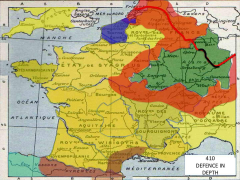 The successful invasion of the Allamanii and the subsequent migrations came as a great shock. Preliminary plans were made for a different border defensive strategy.
The idea was to have self sufficient settlements both sides of the border which also served as homes for armed soldiers.It was planned that the troops consisted predominantly of foederatii, permanently settled in designated areas. Mixed in with these settlers troops from remote other areas of the empire were introduced to enforce coordination and control.
Events outside the Empire, predominantly the move westwards of the Huns, led to even greater pressure on its boundaries.The successful invasion of the Allamanii and the subsequent migrations came as a great shock. Preliminary plans were made for a different border defensive strategy.
The successful invasion of the Allamanii and the subsequent migrations came as a great shock. Preliminary plans were made for a different border defensive strategy.
The idea was to have self sufficient settlements both sides of the border which also served as homes for armed soldiers.It was planned that the troops consisted predominantly of foederatii, permanently settled in designated areas. Mixed in with these settlers troops from remote other areas of the empire were introduced to enforce coordination and control.
Events outside the Empire, predominantly the move westwards of the Huns, led to even greater pressure on its boundaries.The successful invasion of the Allamanii and the subsequent migrations came as a great shock. Preliminary plans were made for a different border defensive strategy.
The idea was to have self sufficient settlements both sides of the border which also served as homes for armed soldiers.It was planned that the troops consisted predominantly of foederatii, permanently settled in designated areas. Mixed in with these settlers troops from remote other areas of the empire were introduced to enforce coordination and control.
Events outside the Empire, predominantly the move westwards of the Huns, led to even greater pressure on its boundaries.
An overall co-ordinated strategy was introduced which emphasised the need for decentralised command.
The typical frontier
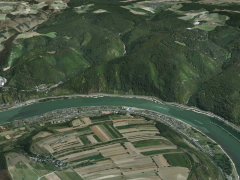 An overall co-ordinated strategy was introduced which emphasised the need for decentralised command.
The geographic nature of the Rhine frontier suggested the strategy which was employed. The strategy was also influenced however by lessons learned far away on the eastern border. In attempting to extend the Empire eastwards the Roman Army had been continually frustrated by the the Pesian and Parthian use of Cavalry.The geographic nature of the Rhine frontier suggested the strategy which was employed. The strategy was also influenced however by lessons learned far away on the eastern border. In attempting to extend the Empire eastwards the Roman Army had been continually frustrated by the the Pesian and Parthian use of Cavalry.
An overall co-ordinated strategy was introduced which emphasised the need for decentralised command.
The geographic nature of the Rhine frontier suggested the strategy which was employed. The strategy was also influenced however by lessons learned far away on the eastern border. In attempting to extend the Empire eastwards the Roman Army had been continually frustrated by the the Pesian and Parthian use of Cavalry.The geographic nature of the Rhine frontier suggested the strategy which was employed. The strategy was also influenced however by lessons learned far away on the eastern border. In attempting to extend the Empire eastwards the Roman Army had been continually frustrated by the the Pesian and Parthian use of Cavalry.
Sythian Horsemen
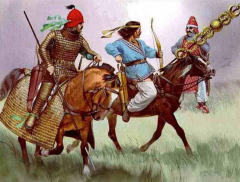 Roman armies had been unable to cope with the use of highly mobile cavalry by the Persian Army. It was decided to replicate the persian tactics. It really was new technology. Horses had to be bred and trained. Riders too, had to be selected and trained. It was a task assigned to a group of Comitas and introdced first against the Vandals in North Africa where the terrain was similar to the terrain in the east, then against the Sueves in Hispania Now after several generations of adaption and experimentation it was judged ready to be used on the Rhine and Danube frontiers.Roman armies had been unable to cope with the use of highly mobile cavalry by the Persian Army. It was decided to replicate the persian tactics. It really was new technology. Horses had to be bred and trained. Riders too, had to be selected and trained. It was a task assigned to a group of Comitas and introdced first against the Vandals in North Africa where the terrain was similar to the terrain in the east, then against the Sueves in Hispania Now after several generations of adaption and experimentation it was judged ready to be used on the Rhine and Danube frontiers.
Roman armies had been unable to cope with the use of highly mobile cavalry by the Persian Army. It was decided to replicate the persian tactics. It really was new technology. Horses had to be bred and trained. Riders too, had to be selected and trained. It was a task assigned to a group of Comitas and introdced first against the Vandals in North Africa where the terrain was similar to the terrain in the east, then against the Sueves in Hispania Now after several generations of adaption and experimentation it was judged ready to be used on the Rhine and Danube frontiers.Roman armies had been unable to cope with the use of highly mobile cavalry by the Persian Army. It was decided to replicate the persian tactics. It really was new technology. Horses had to be bred and trained. Riders too, had to be selected and trained. It was a task assigned to a group of Comitas and introdced first against the Vandals in North Africa where the terrain was similar to the terrain in the east, then against the Sueves in Hispania Now after several generations of adaption and experimentation it was judged ready to be used on the Rhine and Danube frontiers.
Strongpoints and Cavalry
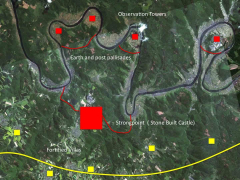 Using fortified elevated observation towers in locations where the views in every direction were in any case excellent, gave early warnings of attempts to cross the river .
Behind the front line would be the new cavalry units which had been developed . Highly mobile heavy cavalry armed with lances, light cavalry armed with long “slashing “ swords, both supported by mounted archers. This force could travel at speed along the paved roads.
The Comitas had been so long involved in the development of this type of cavalry that the new units took their name from their commanders. They became known as the Comitatenses.
Paved roads running parrallel with the frontier, enabled a fast response to any emergency and the interception any intruders.
Close to the road were occasional strong points in the form of stone castles and fortified villas. The soldiers who manned the front line were called Limitanei but were known a little unkindly as “the farmer soldiers”. They were organised on Legionary principles and commanded by Dux. The purpose of this front line was to present any attackers with a dilemma. They could ignore the front line and push on quickly into Roman territory or they could stop and lay seige. If they took the first option the occupants of the strongpoint could emerge, disrupt supply lines and block any retreat. If they took the second option it would cause significant delays to their advance and give the Comitatenses time to arrive in large numbers.Using fortified elevated observation towers in locations where the views in every direction were in any case excellent, gave early warnings of attempts to cross the river .
Using fortified elevated observation towers in locations where the views in every direction were in any case excellent, gave early warnings of attempts to cross the river .
Behind the front line would be the new cavalry units which had been developed . Highly mobile heavy cavalry armed with lances, light cavalry armed with long “slashing “ swords, both supported by mounted archers. This force could travel at speed along the paved roads.
The Comitas had been so long involved in the development of this type of cavalry that the new units took their name from their commanders. They became known as the Comitatenses.
Paved roads running parrallel with the frontier, enabled a fast response to any emergency and the interception any intruders.
Close to the road were occasional strong points in the form of stone castles and fortified villas. The soldiers who manned the front line were called Limitanei but were known a little unkindly as “the farmer soldiers”. They were organised on Legionary principles and commanded by Dux. The purpose of this front line was to present any attackers with a dilemma. They could ignore the front line and push on quickly into Roman territory or they could stop and lay seige. If they took the first option the occupants of the strongpoint could emerge, disrupt supply lines and block any retreat. If they took the second option it would cause significant delays to their advance and give the Comitatenses time to arrive in large numbers.Using fortified elevated observation towers in locations where the views in every direction were in any case excellent, gave early warnings of attempts to cross the river .
Behind the front line would be the new cavalry units which had been developed . Highly mobile heavy cavalry armed with lances, light cavalry armed with long “slashing “ swords, both supported by mounted archers. This force could travel at speed along the paved roads.
The Comitas had been so long involved in the development of this type of cavalry that the new units took their name from their commanders. They became known as the Comitatenses.
Paved roads running parrallel with the frontier, enabled a fast response to any emergency and the interception any intruders.
Close to the road were occasional strong points in the form of stone castles and fortified villas. The soldiers who manned the front line were called Limitanei but were known a little unkindly as “the farmer soldiers”. They were organised on Legionary principles and commanded by Dux. The purpose of this front line was to present any attackers with a dilemma. They could ignore the front line and push on quickly into Roman territory or they could stop and lay seige. If they took the first option the occupants of the strongpoint could emerge, disrupt supply lines and block any retreat. If they took the second option it would cause significant delays to their advance and give the Comitatenses time to arrive in large numbers.
The Comes take control
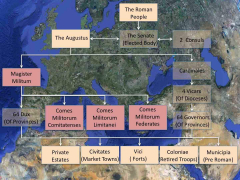 The strategy being used depended totally on local quick decision making. The Comitas were detached from the Dux and given the authority to command not only their troops but civil and other military personnel. Whole districts were put under their command. The organisation created occasional conflict Comitas and Magister Milatorum.
For all this to work the district civil administration had to understand the role of the Comitas and the role the civil population must play. The Comitas became increasingly independent and self reliant in the area they controlled.The strategy being used depended totally on local quick decision making. The Comitas were detached from the Dux and given the authority to command not only their troops but civil and other military personnel. Whole districts were put under their command. The organisation created occasional conflict Comitas and Magister Milatorum.
The strategy being used depended totally on local quick decision making. The Comitas were detached from the Dux and given the authority to command not only their troops but civil and other military personnel. Whole districts were put under their command. The organisation created occasional conflict Comitas and Magister Milatorum.
For all this to work the district civil administration had to understand the role of the Comitas and the role the civil population must play. The Comitas became increasingly independent and self reliant in the area they controlled.The strategy being used depended totally on local quick decision making. The Comitas were detached from the Dux and given the authority to command not only their troops but civil and other military personnel. Whole districts were put under their command. The organisation created occasional conflict Comitas and Magister Milatorum.
For all this to work the district civil administration had to understand the role of the Comitas and the role the civil population must play. The Nobiles Comitas became increasingly independent and self reliant in the area they controlled. From these origins came the Counts of Western Europe; the new nobility.
